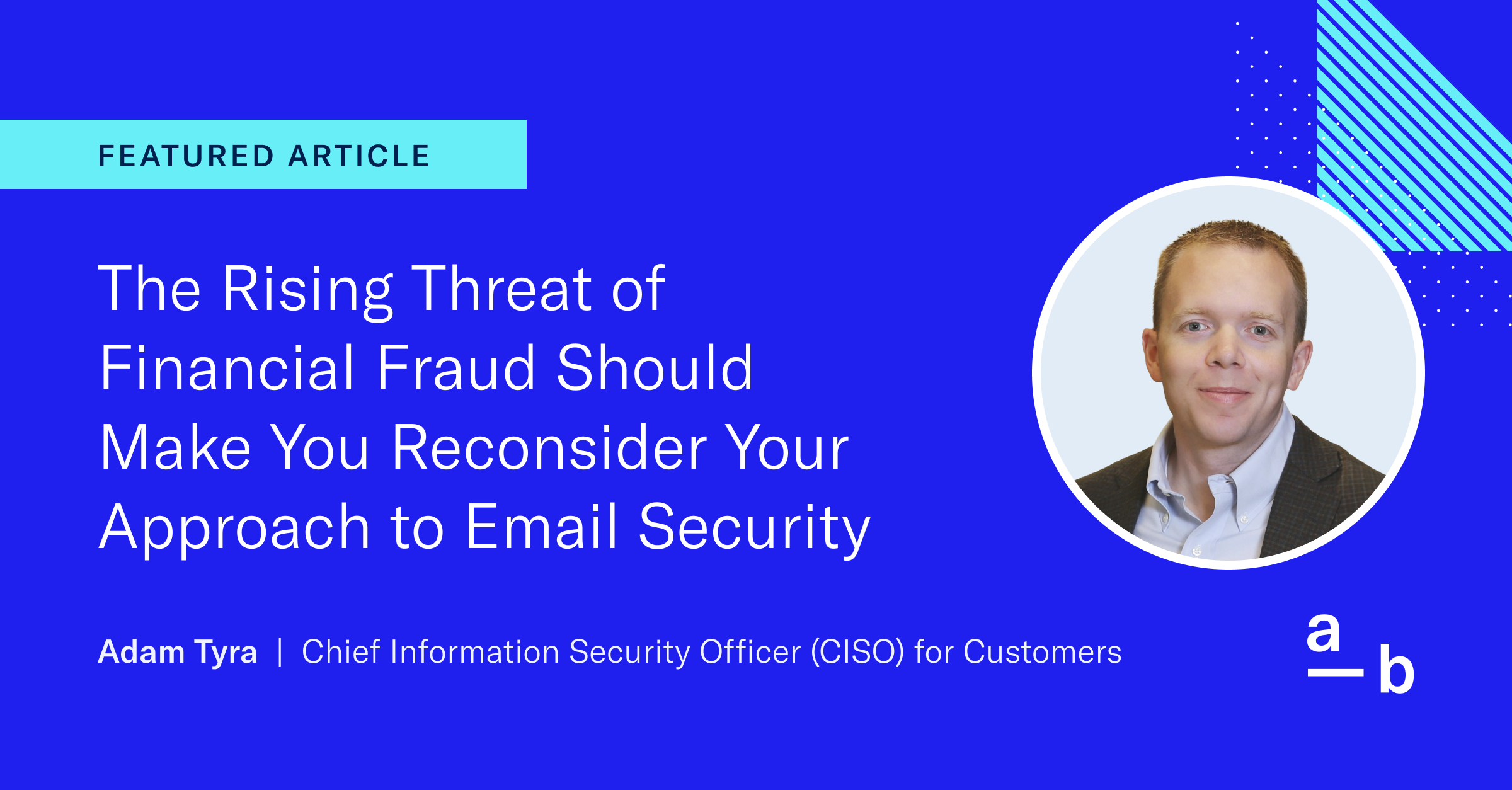Article
Quick Wins to Improve Fraud Defenses
As seen in Cybersecurity Insiders, this article from At-Bay’s CISO for Customers, Adam Tyra, explores the compelling case that in today’s AI-driven threat landscape, gamified phishing trainings may not be as effective with reducing email crime.
Recent 2024 insurance data reveals a striking shift in cyber threats facing businesses: financial fraud now accounts for 32% of cyber insurance claims, making U.S. companies nearly twice as likely to suffer from financial fraud than a ransomware attack. This surge is coupled with rising incident costs — the average financial fraud loss has climbed to $268K, surpassing the typical maximum cyber insurance coverage of $250K. One company generating under $25 million in revenue lost $5.2 million in a single fraudulent transaction. With multiple cases of multimillion-dollar losses, the urgency for stronger defenses is now paramount.
Why Financial Fraud is So Pervasive
A staggering 83% of fraud incidents begin with email, despite many impacted businesses using popular email security tools like Proofpoint and Mimecast. This reveals a critical weakness in email where traditional email security solutions, focused on blocking malicious links and attachments, are proving ineffective at stopping today’s most pervasive email crime – impersonation fraud and social engineering attacks.
How Security Leaders Can Strengthen Defenses
Improving fraud resilience is achievable through targeted policies, governance, and adopting advanced email security tooling. Here’s a best practice roadmap:
1. Mandate Rigorous Authentication Procedures for Funds Transfers
The strongest barrier to financial fraud is well-defined, enforced policies around funds transfers. Staff handling payments must rigorously verify every transaction request, especially those that deviate from established patterns.
Notably, about 75% of fraud incidents involve transactions with known vendors or partners, and 64% relate to current due payments to those vendors. Attackers exploit this by impersonating trusted vendors to request changes in banking details in about 50% of cases. Yet, a 2024 J.D. Power study found only 4-7% of small businesses switch primary banks annually, making such “change of bank” notices highly suspicious.
Organizations should treat any notification of banking changes as potentially fraudulent, mandating confirmation through trusted methods like phone calls or face-to-face meetings. Policies must instruct employees to consider any alteration during active or pending transactions as suspicious, and offer clear steps to authenticate requests.
This simple administrative control requires no advanced cybersecurity skills or additional tooling, but dramatically reduces fraud risk.
2. Revisit Expectations for Security Training and Balance with New Email Security Tooling
As reported on by Dark Reading, research from the University of California at San Diego shows even well-trained employees fail to spot phishing emails 15% of the time. This is particularly problematic for fraud attempts as they don’t always display common phishing indicators. Security leaders must temper their expectations for the potential of training in helping employees spot fraud attempts.
Fortunately, next-generation email security tools employing AI and natural language processing can detect fraud attempts by analyzing email content for subtle cues—such as urgency, authority, and emotional manipulation. Fraud emails often use phrases like, “If this payment doesn’t go through immediately, the company risks contract loss or litigation,” pressuring recipients to act hastily. The latest email security tools use AI to analyze the content and meaning of emails and can therefore identify such semantic indicators of fraud.
Security leaders should consider investing in AI-powered email defenses. Ensure that they’re capable of identifying and flagging suspicious messages that appear to be associated with fraud. Coupled with an effective policy for authenticating messages as described above, the additional detective capability of leading edge email security tools can catch many fraud attempts that go otherwise unnoticed.
3. Accelerate Fraud Detection & Incident Response
Unlike ransomware, which is often detected within minutes according to Verizon’s 2025 Data Breach Report, fraud incidents, by contrast, might go undiscovered for months. Sometimes they are only uncovered when a vendor sends a past due notice for a paid invoice.
Early detection is critical to recovering stolen funds and minimizing damage. A practical policy is to require payment verification through alternate channels before executing transactions, especially for larger sums (e.g., payments above $10,000). For example, finance staff could confirm outgoing payments by calling a pre-verified vendor number. If verification fails, immediate incident reporting and investigation procedures must kick in.
Prompt detection can enable banks and financial institutions to halt or reverse fraudulent transactions—significantly reducing losses or preventing them altogether.
Conclusion: Improved Fraud Resilience
Financial fraud is stealthier and costly as ever, but organizations can make significant improvements to their fraud resilience by improving administrative and procedural controls around financial transactions, and also introducing new tooling. Taken together, these steps will yield significantly improved fraud defense for relatively little investment.




